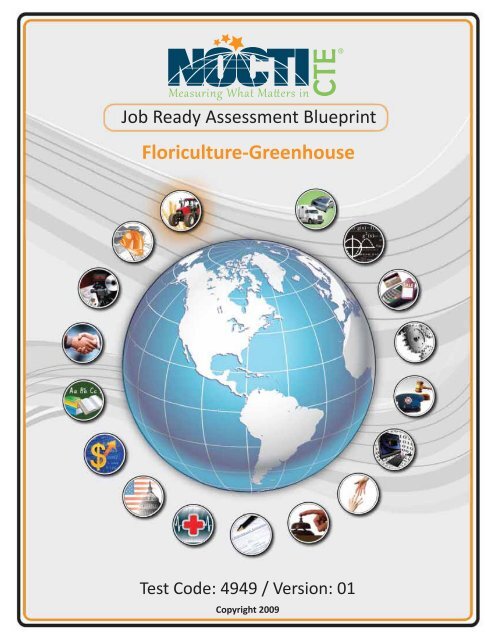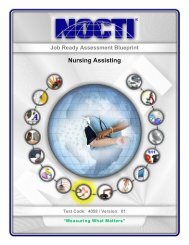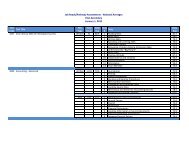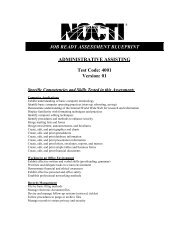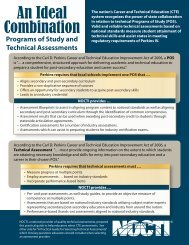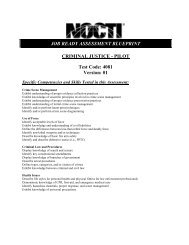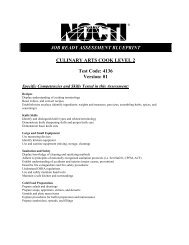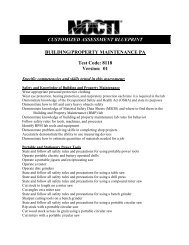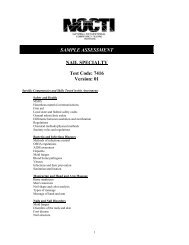Blueprint- Floriculture-Greenhouse- 4949 2012 - nocti
Blueprint- Floriculture-Greenhouse- 4949 2012 - nocti
Blueprint- Floriculture-Greenhouse- 4949 2012 - nocti
You also want an ePaper? Increase the reach of your titles
YUMPU automatically turns print PDFs into web optimized ePapers that Google loves.
Measuring What Matters in<br />
Job Ready Assessment <strong>Blueprint</strong><br />
<strong>Floriculture</strong>-<strong>Greenhouse</strong><br />
Test Code: <strong>4949</strong> / Version: 01<br />
Copyright 2009
<strong>Floriculture</strong>-<strong>Greenhouse</strong><br />
General Assessment Information<br />
<strong>Blueprint</strong> Contents<br />
General Assessment Information<br />
Written Assessment Information<br />
Specific Competencies Covered in the Test<br />
Sample Written Items<br />
Performance Assessment Information<br />
Sample Performance Job<br />
Test Type: The <strong>Floriculture</strong>-<strong>Greenhouse</strong> assessment is included in NOCTI’s Job Ready<br />
assessment battery. Job Ready assessments measure technical skills at the<br />
occupational level and include items which gauge factual and theoretical knowledge.<br />
Job Ready assessments typically offer both a written and performance component and<br />
can be used at the secondary and post-secondary levels. Job Ready assessments can<br />
be delivered in an online or paper/pencil format.<br />
Revision Team: The assessment content is based on input from secondary,<br />
post-secondary, and business/industry representatives from the states of Idaho,<br />
Oklahoma, New York, Pennsylvania, and West Virginia.<br />
cip<br />
Code<br />
01.0608 - <strong>Floriculture</strong>/Floristry<br />
Operations and Management<br />
Career Cluster 1 - Agriculture, Food<br />
and Natural Resources<br />
27-1023.00 -<br />
Floral Designers<br />
The Association for Career and Technical Education (ACTE), the leading professional<br />
organization for career and technical educators, commends all students who<br />
participate in career and technical education programs and choose to validate their<br />
educational attainment through rigorous technical assessments. In taking this<br />
assessment you demonstrate to your school, your parents and guardians, your future<br />
employers and yourself that you understand the concepts and knowledge needed to<br />
succeed in the workplace. Good Luck!<br />
In the lower division<br />
baccalaureate/associate degree<br />
category, 3 semester hours in<br />
Fundamentals of<br />
<strong>Floriculture</strong>-<strong>Greenhouse</strong><br />
NOCTI Job Ready Assessment<br />
Page 2 of 10
<strong>Floriculture</strong>-<strong>Greenhouse</strong><br />
Written Assessment<br />
NOCTI written assessments consist of questions to measure an individual’s factual<br />
theoretical knowledge.<br />
Administration Time: 3 hours<br />
Number of Questions: 196<br />
Number of Sessions: This assessment may be administered in one, two, or three sessions.<br />
Areas Covered<br />
Basic Floral Design<br />
10%<br />
20%<br />
Intermediate Floral Design<br />
12%<br />
Advanced Floral Design<br />
7%<br />
Small <strong>Floriculture</strong> or<br />
<strong>Floriculture</strong>-<strong>Greenhouse</strong> Business<br />
18%<br />
Plant Sciences<br />
15%<br />
Soil Sciences<br />
9%<br />
<strong>Greenhouse</strong> Operations<br />
19%<br />
NOCTI Job Ready Assessment<br />
Page 3 of 10
Specific Competencies and Skills Tested in this Assessment<br />
<strong>Floriculture</strong>-<strong>Greenhouse</strong><br />
Basic Floral Design<br />
• Display basic safe work practices<br />
• Identify and correctly use floral supplies and tools<br />
• Use ribbons and accessories in floral design<br />
• Design and create basic arrangements<br />
• Process, condition, and store plants and cut flowers<br />
• Exhibit knowledge of shop sanitation, including coolers, containers, and buckets<br />
• Identify cut materials and plants<br />
• Display basic knowledge of floral design history<br />
Intermediate Floral Design<br />
• Create and design permanent floral arrangements<br />
• Safely use steel pick machine, hot glue gun, and other floral adhesives<br />
• Apply the principles and elements of floral design<br />
• Exhibit knowledge of various floral wire services (FTD®, Teleflora®, and electronic<br />
services)<br />
Advanced Floral Design<br />
• Design and create various holiday and special occasion arrangements<br />
• Apply knowledge and competence with wedding designs and accessories<br />
• Apply knowledge and competence with funerals and sympathy work<br />
(Continued on the following page)<br />
NOCTI Job Ready Assessment<br />
Page 4 of 10
<strong>Floriculture</strong>-<strong>Greenhouse</strong><br />
Specific Competencies and Skills (continued)<br />
Small <strong>Floriculture</strong> or <strong>Floriculture</strong>-<strong>Greenhouse</strong> Business<br />
• Identify and describe business categories (sole proprietor, partnership, etc.)<br />
• Exhibit knowledge of proper floriculture salesmanship techniques, customer<br />
relations, including telephone etiquette<br />
• Set up effective merchandise displays and window displays<br />
• Exhibit knowledge of effective floriculture advertising techniques<br />
• Correctly price and determine costs of floral arrangements<br />
• Apply knowledge of correct inventory procedures, shipping/receiving, and<br />
completing invoices<br />
• Apply business math (invoice, payroll, labor, etc.)<br />
• Identify and describe careers/jobs within the floral and/or greenhouse industry<br />
Plant Sciences<br />
• Classify plants using binomial nomenclature<br />
• Identify and describe plant life cycles<br />
• Identify and describe plant anatomy and physiology<br />
• Exhibit understanding of sexual and asexual plant reproduction<br />
(Continued on the following page)<br />
NOCTI Job Ready Assessment<br />
Page 5 of 10
<strong>Floriculture</strong>-<strong>Greenhouse</strong><br />
Specific Competencies and Skills (continued)<br />
Soil Sciences<br />
• Identify and describe soil microbiology, components, and classification<br />
• Describe drainage dynamics and types<br />
• Identify and describe essential and trace elements, interactions, and availability<br />
• Analyze soil test results<br />
• Identify and describe types of growing media<br />
<strong>Greenhouse</strong> Operations<br />
• Correctly select appropriate structures, sites, and layouts for greenhouses<br />
• Describe various watering techniques<br />
• Describe environmental factors that affect crop production<br />
• Apply methods of propagation (i.e., sexual, asexual)<br />
• Identify types and uses of fertilizers<br />
• Describe concepts and practices of integrated pest management (IPM)<br />
• Identify and describe greenhouse-related worker protection standards<br />
• Describe various effective methods of greenhouse climate control<br />
• Identify greenhouse crops<br />
• Identify and use greenhouse-related containers<br />
• Identify and describe insect types, anatomy, and life cycles<br />
NOCTI Job Ready Assessment<br />
Page 6 of 10
<strong>Floriculture</strong>-<strong>Greenhouse</strong><br />
Sample Questions<br />
Artistry and design principles are most important to an individual seeking a career in<br />
A. greenhouse production<br />
B. plant science<br />
C. retail floristry<br />
D. soil science<br />
Steel pick machines use steel picks that may<br />
A. come with or without wire attached<br />
B. be useful for cutting heavy stems<br />
C. cut fingers because they are sharp<br />
D. be purchased in various colors<br />
The two most common tools used for fresh flowers designs are a<br />
A. styrofoam cutter and ribbon shears<br />
B. staple gun and wire cutters<br />
C. sharp knife and floral shears<br />
D. stem stripper and pruners<br />
What is the scientific name (binomial nomenclature) for the carnation?<br />
A. lilium longiflorum<br />
B. erica carnea<br />
C. hyacinthus orientalis<br />
D. dianthus caryophyllus<br />
The term, scarification, describes a method of<br />
A. reducing scars on a stem of a plant<br />
B. subjecting seeds to cold weather to aid germination<br />
C. detecting plant disease<br />
D. mechanically helping a seed to take in water<br />
(Continued on the following page)<br />
NOCTI Job Ready Assessment<br />
Page 7 of 10
<strong>Floriculture</strong>-<strong>Greenhouse</strong><br />
The term, _______, describes the process of cell division that allows plants to<br />
be propagated vegetatively.<br />
A. mitosis<br />
B. meiosis<br />
C. osmosis<br />
D. symbiosis<br />
FTD® and Teleflora® are examples of<br />
A. floral wire services<br />
B. nationwide flower shop chains<br />
C. flower trade names<br />
D. floral telemarketing companies<br />
A bud vase design is<br />
A. triangular<br />
B. one-sided<br />
C. horizontal<br />
D. voluminous<br />
Sample Questions (continued)<br />
The _____ of the plant produces or manufactures food.<br />
A. root system<br />
B. stem<br />
C. leaf<br />
D. hair root<br />
Tropical foliage plants grown in greenhouses include<br />
A. philodendron, crocus, and petunia<br />
B. philodendron, bromeliad, and petunia<br />
C. philodendron, bromeliad, and anthurium<br />
D. bromeliad, ficus, and crocus<br />
NOCTI Job Ready Assessment<br />
Page 8 of 10
<strong>Floriculture</strong>-<strong>Greenhouse</strong><br />
Performance Assessment<br />
NOCTI performance assessments allow individuals to demonstrate their acquired skills by<br />
completing actual jobs using the tools, materials, machines, and equipment related to<br />
the technical area.<br />
Administration Time: 2 hours and 55 minutes<br />
Number of Jobs: 5<br />
Areas Covered:<br />
19% Isosceles Triangle Arrangement<br />
Participants will calculate wholesale cost, resale<br />
cost, and margin of profit for the arrangement,<br />
prepare the container, design the arrangement<br />
and handle the equipment well.<br />
25%<br />
19%<br />
20%<br />
26%<br />
25% Design a Multi-Flower Corsage<br />
Participants will appropriately select flowers and foliage,<br />
assemble, decorate, and package the corsage.<br />
10%<br />
10% Cash Register/Sales<br />
Participants will greet the customer, complete the receipt, calculate the bill, count back<br />
change and close the sale.<br />
26% Plant Classification and Identification<br />
Participants will correctly identify annuals, perennials, cut flowers, house plants, and<br />
cut foliage.<br />
20% Start/Propagate Herbaceous Plant from a Stem Tip Cutting<br />
Participants will be organized and prepare containers, cut harvesting, prepare the<br />
cuttings, stick the cuttings, prepare labels and place containers, and clean up.<br />
NOCTI Job Ready Assessment<br />
Page 9 of 10
<strong>Floriculture</strong>-<strong>Greenhouse</strong><br />
Sample Job<br />
Start/Propagate Herbaceous Plant from a Stem Tip Cutting<br />
Maximum Time: 25 minutes<br />
Participant Activity: The participant will prepare 12 containers for starting, by direct<br />
sticking, 12 herbaceous plant cuttings. Harvest cuttings from a stock plant and<br />
demonstrate sterile techniques using a florist’s knife. Prepare cuttings and treat with<br />
rooting compound. Properly stick the cuttings into the containers. Label the containers<br />
and place potted plants in the greenhouse. Clean up work area and return supplies to<br />
original location.<br />
NOCTI Job Ready Assessment<br />
Page 10 of 10


